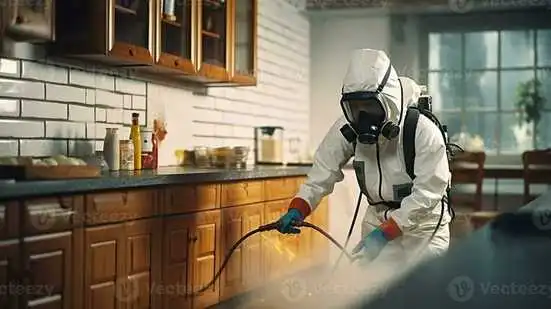Using a fogger to resolve your pest problem can seem like a quick fix. These devices, also known as total release insecticide products, are often misunderstood and, if used incorrectly, can be dangerous. This guide is designed to give you a clear and complete path to using them effectively. We’ll cover everything from choosing the right product to the essential safety steps and post-treatment cleanup.
Understanding Foggers
A fogger, commonly called a bug bomb, is a device that releases a fine mist of insecticide. This “fog” of tiny droplets is designed to cover a large area, settling on surfaces and reaching spots that are hard to get to with other treatments (in terms of space covered). These products use aerosol propellants that are often flammable, which is why proper use is crucial to prevent fires or explosions.

Are They the Right Solution for Your Pest Problem?
While foggers are easy to find, they are not completely effective for most pest infestations. The insecticide mist can’t get into the cracks, crevices, or walls where many pests hide and breed. Plus, the effect is temporary, offering little to no lasting protection.
When Foggers Can Be Effective:
- Targeting Exposed Pests: They work best on airborne or surface-dwelling pests like flies, mosquitoes, wasps, and ants.
- Providing Temporary Relief: A fogger can give you immediate, short-term relief from flying insects in a treated area.
When Foggers Are NOT Effective:
- For Infestations, they are almost useless for pests that hide, such as cockroaches, fleas, and bed bugs. These pests simply retreat into their hiding spots and avoid the mist.
- For Lasting Results: A fogger will not solve the pest problem for good. It attacks only the pests you can see, leaving the source of the infestation, like nests and eggs hidden in walls and cracks, untouched. This means new pests will likely return soon.
A Step-by-Step Guide to Safe Fogger Use
Follow these steps carefully to ensure both safety and effectiveness.
Step 1: Choosing the Right Product
- Identify the Pest: Always choose a fogger designed for the specific pest you’re targeting. Using the wrong product can be ineffective and even dangerous.
- Calculate the Right Size: These foggers are designed for indoor use in enclosed spaces. Never use more foggers than you need. To find the right size, measure the volume of your space (length x width x height) for each room and add them together. For example, a 10 ft. x 10 ft. room with an 8 ft. ceiling has a volume of 800 cubic feet. Read the product label to match the fogger size to your space.
- Consider the active ingredient: When you choose a fogger, don’t just look at the brand; look at the active ingredient on the label. Some foggers use pyrethrum-based insecticides, which are often considered safer for indoor use because they break down quickly, significantly reducing the risk of lingering chemical residues in your home. This is a crucial factor for ensuring safety after treatment.

Step 2: Preparing Your Home for Treatment
This is the most critical step to prevent accidents and ensure the treatment works.
- Remove All Occupants: This is a non-negotiable first step. Everyone, including people, pets, and houseplants, must leave the area. The pesticide mist is harmful if inhaled or if it touches the skin.
- Protect Food and Personal Items: Cover all food and pet food, or store them in sealed containers. Place dishes and utensils in cupboards or cover them completely. Cover children’s toys and countertops with plastic or newspaper. Pull bedding over pillows and consider covering or removing any clothing left out in the open.
- Eliminate All Fire Hazards: This step is essential to prevent explosions. Turn off all pilot lights on gas appliances, including stoves, water heaters, and clothes dryers. If you need help, contact your local gas utility. Unplug any appliances that can turn on and off automatically, such as refrigerators, air conditioners, and computers, to prevent sparks. Place the fogger at least six feet away from all ignition sources.
- Ensure Effective Treatment: Open all interior doors, empty cabinets, drawers, and closets to allow the fog to reach as much of the area as possible.
Step 3: Activating the Fogger and Exiting
- Wear Protective Gear: Put on gloves and a mask to protect your skin and lungs.
- Position the Fogger: Place the fogger in the center of the room on a protected surface, like a chair or a table covered with newspaper.
- Activate and Exit: With the fogger pointed away from your face, press the valve down to activate it, set it on the prepared stand, and leave the premises immediately.
- Post a Warning Sign: Put a prominent warning sign on your front door to alert family members, neighbors, or anyone else who might try to enter. Do not re-enter the treated area for at least two to four hours, or for the time specified on the product label. Entering too soon can lead to illness from inhaling the mist.

Step 4: Post-Application Safety and Cleanup
- Ventilate: Once you return, open all windows and doors to thoroughly air out the space. Use fans to help remove any remaining fog.
- Clean Up: After the area is completely ventilated, wipe down all surfaces that may have been exposed to the pesticide to remove any residue.
- Safety: After use, ensure all pesticide products are stored safely out of reach of children and pets, ideally in a locked cabinet.
Conclusion
By following every step in this guide, you can use a fogger confidently and safely. See our articles on pest control.





